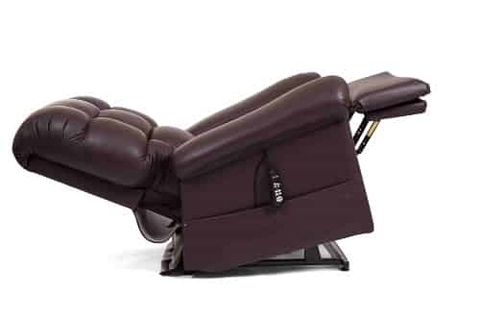After surgery, choosing the right equipment to facilitate a comfortable and safe recovery is essential. While hospital beds are commonly used for post-op recovery, lift chairs offer several advantages that make them a better choice for many patients. This article will explore why a lift chair may be a better option than a hospital bed for post-op recovery.
Many Reclining lift chairs come with built-in accessories
Several accessories can improve the user's comfort and functionality when setting up a lift chair. Lift chairs are designed to provide comfort, support, and assistance to individuals with mobility issues or those who may need help getting up and down from a seated position. as a result, almost all of the below accessories come in with the lift chair such as

- Seat Cushion: A seat cushion can provide additional comfort and support for the user, especially for those sitting in the lift chair for extended periods. Seat cushions come in various materials and thicknesses to meet users' needs.
- Lumbar Support: Lumbar support cushions can provide extra support for the lower back and help alleviate discomfort caused by prolonged sitting.
- Head Pillow: A head pillow can provide additional neck support and increase the user's comfort while sitting in the lift chair.
- Heat and Massage Function: Many lift chairs come with a built-in heat and massage function that can help alleviate muscle soreness and stiffness.
- Side Table: A side table can provide a convenient surface for the user to place items such as a book, beverage, or remote control.
- Cup Holder: A cup holder can provide a convenient way for the user to keep a drink nearby without the risk of spilling.
- Remote Control Holder: A remote control holder can keep the lift chair's remote within easy reach, making it more convenient for the user to adjust the chair's position.
- Footrest Extension: A footrest extension can provide extra leg support for taller users or those with longer legs.
- Lift Chair Cover: A lift chair cover can protect the chair's upholstery from stains, spills, and wear and tear.
Hospital bed
When setting up a hospital bed, several accessories may be needed to provide the patient with maximum comfort and support. The accessories required may vary depending on the patient's specific needs and the type of hospital bed being used.
- Mattress: A high-quality mattress is essential for providing the patient with comfortable support. Hospital bed mattresses come in a range of materials and designs, from foam to air to alternating pressure mattresses for patients at risk of bedsores.
- Bedrails: Bedrails are used to prevent the patient from falling out of bed, especially when they are not able to move around on their own. Bedrails can be adjustable and come in different lengths to suit the patient's needs.
- Overbed Table: An overbed table gives the patient a stable surface to eat, drink, or use their laptop or other devices while lying in bed. These tables can be adjustable in height and angle for comfortable use.
- Trapeze Bar: A trapeze bar is a triangular metal frame that hangs above the bed and is used by patients to adjust their position or move. It is especially helpful for patients with limited mobility or recovering from surgery.
- Call Bell: A call bell is an essential accessory that allows the patient to summon the nursing staff in case of an emergency or to request assistance.
- Bedside Commode: A bedside commode is a portable toilet that can be placed next to the bed for patients who cannot get up and go to the bathroom. These commodes can be used as a temporary solution until the patient is able to move around on their own.
- Bedside Organizer: A bedside organizer is a small shelf that can be attached to the bed frame and used to store items such as books, glasses, and other personal items.
- IV Pole: An IV pole holds an IV bag and supports medical equipment, such as a feeding pump or oxygen tank.
In conclusion, these are some of the essential accessories that are needed for a hospital bed. When setting up a hospital bed, it is essential to consider the patient's specific needs and to provide them with the necessary accessories for their comfort and well-being.
Easier Mobility:
Hospital beds are bulky and difficult to move, making it challenging for patients to get up and move around. In contrast, lift chairs are much smaller and more mobile, making it easier for patients to get up and move around. This is important for preventing complications such as blood clots and muscle atrophy, which can arise from prolonged bed rest.
Improved Comfort:
Lift chairs are designed for maximum comfort, with features such as padded seats, backrests, and armrests. These features can help reduce pain and discomfort associated with post-op recovery, allowing patients to relax and recover more comfortably. Hospital beds, on the other hand, are designed primarily for medical needs and may be less comfortable for extended periods of use.
Less Dependency:
Hospital beds require assistance from caregivers for adjustments such as raising and lowering the bed or changing the patient's position. This can create a feeling of dependency in patients, which can harm their mental and emotional well-being. On the other hand, lift chairs can be operated independently by the patient, giving them more control over their recovery and reducing feelings of dependency.
Conclusion:
While hospital beds are commonly used for post-op recovery, lift chairs offer several advantages that make them a better choice for many patients. Lift chairs can help reduce the risk of infection, promote easier mobility, improve comfort, and reduce feelings of dependency. If you or a loved one is undergoing post-op recovery, consider using a lift chair for a more comfortable and safe recovery experience.